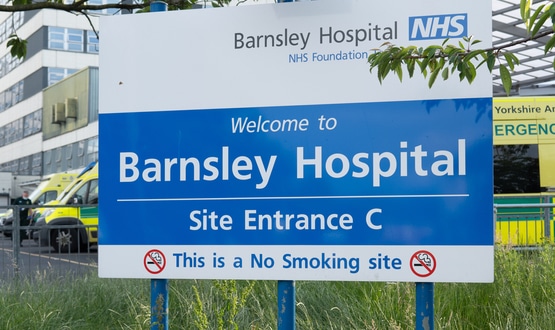CRRSing the digital divide
- 2 September 2013

Making the change from paper to electronic systems is a bit like making the move from vinyl records to digital mp3 files, says Danny Roberts.
The EPR programme director of University Hospitals Coventry and Warwickshire NHS Trust wants to see his organisation go paperless by 2016, and argues that the move to electronic records should not be seen as some huge hurdle.
“We went from scribbling in the sand to paper and from vinyl to digital music. Everyone’s used to going online. Using electronic health records isn’t such a big step,” he says.
However, he realises clinicians might not always see it that way. “People are trying to do their job; teaching them how to do it differently is a challenge.”
Building on CRRS
Some EHI readers have suggested that University Hospitals Coventry and Warwickshire as an example of a trust that has made strides in using IT that others could learn from in ‘The Hunt for EPR Exemplars’.
It set up an EPR programme board last year, and has decided on a ‘best of breed approach’. This will see it use an in-house clinical results reporting system, also known as the CRRS, as a base for a three-pillar approach to a full EPR system.
The other pillars are an electronic patient observation track and trigger system, and an electronic document management system to handle the remaining paper.
“We’ve had CRRS for 15 years,” says Roberts. “It’s an in house build that we’ve improved and developed over time.”
CRRS does more than just results. It acts as a clinical data repository, handles clinical letters, test requests, e-handover, results and acknowledgments. It also acts as a portal and links to other systems.
“It’s something we’re proud of and clinicians love it,” Roberts says, giving, as an example of why that might be the case, the way the system has been able to send discharge summaries to GPs across Coventry for years.
“All the GPs have also got access to the CRRS so they can view a summary of patient information,” he adds.
Improved and new
The trust is planning a huge upgrade of its CRRS system next year. This will include integrating Choose and Book and improving e-discharge.
But the trust’s iSoft / CSC iPM patient administration system, which it received under NPfIT, is staying put for now.
Roberts says there are talks about possibly extending the contract until 2020, although there are some issues with extending an NPfIT deal. “Because it’s NPfIT, we can’t put any information pack into the PAS automatically,” he says.
The trust implemented a new, Insignia picture archiving and communications system in June as part of an implementation across its local health community. This means the trust can share images with other local trusts, using the NHS Number as the primary identifier.
“We previously used the Image Exchange Portal, which was a challenge, but one that will now go away. Using the NHS Number you can easily pull images from other trusts, which we are very excited about.”
The next pillar of its EPR plans is an EDMS. It is running a procurement and Roberts hopes it will have chosen a supplier by the end of the financial year.
The trust also needs an e-prescribing system, which is easier said than done. “The EPMA business case is difficult. We do not have the funding for it,” Roberts says.
He is keeping his fingers crossed that a bid the trust put in to the ‘Safer Hospitals, Safer Wards’ Technology Fund will come through.
“We wouldn’t be able to do e-prescribing at the moment without the funding,” he adds. E-prescribing is only one of many bids the trust put in to the £260m fund, which NHS England is now evaluating.
It is also looking for a new A&E system, which is due for replacement next year, and some money to run a second procurement for a new electronic patient observation track and trigger system.
At the moment, the trust uses VitalPAC, which is popular, but runs on increasingly out of date mobile devices. The trust went out to tender for a replacement earlier this year, but ended up “quite disappointed”.
“We abandoned the procurement because there were no compliant bids that met our specifications,” Roberts says. “We made the mistake of looking for what we wanted [only to find that] the market still isn’t there.”
Fortunately, VitalPAC works just fine for the time being. The system, which runs on handheld Motorola devices, lets nurses record observations by the patient’s bedside. It also works like an electronic whiteboard.
Changing minds
In theory, the trust is not far away from having a full EPR. Even if it wants to upgrade parts of it, it already has a PAS, both A&E and maternity systems, several specialist systems, requests and results reporting, patient observations, e-discharge summaries and e-referrals. It has plans for e-prescribing, to round off the basics, and for an EDMS.
But EPR programme manager Bev Thompson says there is still some resistance from staff to taking full advantage of the technology.
“People trust what they know. It’s cultural. The older consultants were brought up with paper and they think it feels more personal, as it has their touch and ownership,” she says. “Some members of our nursing staff aren’t particularly technologically adept either,” she adds with a smile.
Some clinicians though, are very enthusiastic about IT. One of them is Richard King, an orthopaedic consultant. He showed up at the door of the IT department one day and demanded mobile access to both the systems that he uses and to the internet.
“I’m really interested in technology,” he says. “My perspective is that I want to be able to put as much information in the patient’s record as easily as possible, without having to leave the bedside in search of a free desktop.”
The mobile phone signal saga
The trust moved into brand new, and very impressive, hospital buildings in 2006. However, this embroiled it in a long saga to do with PFI buildings and mobile phone signals.
“In most parts of the building there is no phone signal,” says Thompson. To get around this, Coventry has come up with a scheme that lets staff register their phones with the trust, which gives them access to the intranet.
Coventry and Warwickshire invested in a new wi-fi network from Cisco a few years back. This has not only enabled it to give staff access, but to run other services as well.
Using the Cisco Jabber app, phones can be used as ‘bleeps’, with each consultant having his or her own extension.
King, the consultant orthopaedist and mobile enthusiast, says this has made a huge difference. “It’s outrageous that in this day and age we still carry around a bleep. I have my extension on my phone now instead,” he says.
The scheme works on iPhones and BlackBerry smartphones and the trust is just setting up for Android phones. It also has a large mobile working project, which includes a bring your own device strategy that lets clinicans use iPads to access patient records at the bedside.
“It’s strictly speaking in pilot mode. It’s about 50 iPads and probably something over 100 phones at the moment. We’ve got to do some security things in the background before it’s officially the end of the pilot mode,” says Roberts.
The project means clinicians can get access to the trust’s CRRS system on their devices. “It’s made a huge difference to doctors and nurses on the ward,” says King.
“I can look at my operation list from yesterday for example, and I can look at the patient observations, requests, scans…” he adds, showing how the CRRS system translates onto his iPad.
All he wants now is an iPad app in which to view the system. He takes advantage of EHI’s visit to add to his pleas to the IT department to develop one.
“I want an app for the CRRS because using Windows on an iPad is like asking a supermodel to wear a fat suit,” he says, bluntly.
Integration is the key
The app may have to wait, as Roberts has got plenty of projects on the go as it is. The keyword, he says, is integration.
“We want to integrate everything with the CRRS,” he says firmly. He is convinced that the trust really can go paperless by 2016 and for clinicians who do not want to get on board, he has a half joking message: “If you don’t want to get on board I will leave you behind.”



